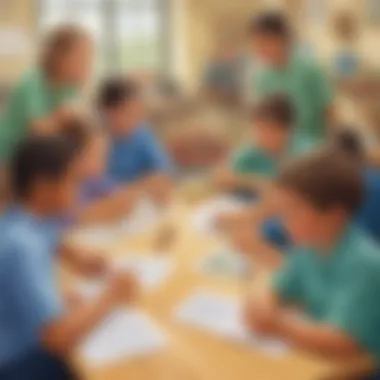Engaging Lesson Plan for Teaching Compound Words


Intro
Understanding compound words is essential for elementary students as they begin to explore the complexities of the English language. Compound words are created when two or more words join to form a new word with a distinct meaning. This concept enhances language development by expanding vocabulary and honing both comprehension and expressive skills. It encourages creativity and critical thinking asstudents learn to deconstruct and reconstruct familiar words into newlyunified forms.
In this lesson plan, educators will find a range of structured activities aimed at making learning about compound words engaging and effective. From creative craft ideas to a variety of quizzes, each section of this plan is strategized to cultivate and reinforce students' grasp of compound words, thereby nurturing their overall linguistic abilities. Moreover, assessment strategies included offer teachers the needed means to measure students' understanding actively.
Creative Activities
Engaging children with creative activities allows for hands-on learning, integrating play with education. Below are some ideas tailored for teaching compound words.
Craft Ideas
- Compound Word Art: Gather various magazines or printouts. Ask students to cut out pictures that represent different words, such as
Preamble to Compound Words
Understanding compound words is vital for both language acquisition and effective communication. For elementary students, the learning process involves breaking down and comprehending how word combinations form new meanings. This foundational grasp not only enhances vocabulary but also trains students in critical analytical thinking skills. By exploring the characteristics and functions of compound words, educators can significantly improve the way students interact with language.
Definition of Compound Words
Compound words are formed by merging two separate words into one cohesive term. Examples include "toothbrush" and "basketball." The synthesized meaning often encompasses ideas from both original words, which can make comprehension more intuitive for young learners. Recognizing these meanings helps facilitate language development, showing the interconnectedness of vocabulary.
Types of Compound Words
Closed compound words
Closed compound words are when two words are joined without spacing or punctuation, for instance, "mailbox". This type is significant in this article, as it demonstrates a clear and streamlined way to create new meanings. Closed compounds often enhance reading fluency since the combined term can be instinctively recognized as a single unit. They also serve as good practical examples for students, emphasizing how everyday language works.
Hyphenated compound words
Hyphenated compound words keep a visual distinction between the constituent parts through hyphens, like "mother-in-law." This unique characteristic allows nuances in meaning that may not be as apparent in closed compounds. Moreover, such words can clarify relationships between objects or ideas. Utilizing hyphenated terms frequently in instruction provides students with a broader spectrum of language understanding. This approach is beneficial as it illuminates precise meanings and contexts.
Open compound words
Open compound words consist of two separate words functioning as one, such as "ice cream". One key attribute of open compounds is their high frequency in day-to-day language. This form may contribute to students’ word recognition, thereby fostering their reading skills. Moreover, they serve as excellent stepping stones while conveying the essential message of cohesion, thereby reinforcing the concept of unity in vocabulary.
Importance of Learning Compound Words
Grasping compound words is essential to developing a rich vocabulary and enhancing linguistic abilities. Compound words serve as bridges connecting vocabulary, thus enriching both expressive and receptive language. As students engage with these compounded forms, they inadvertently improve in reading comprehension skills. This increment not only benefits academic performance but lays a strong foundation for effective communication in everyday life.
Learning these word forms cultivates creativity, as students might enjoy forming their own compounds. With extensive practice in incorporating and analyzing compound words, students emerge with clearer cognitive patterns that assist lifelong language proficiency.
Objectives of the Lesson Plan
The objectives of this lesson plan play a crucial role in shaping the educational journey for students learning about compound words. An effective lesson plan goes beyond just teaching definitions; it focuses on multidimensional goals that enhance cognitive and social skills among elementary school students. The following objectives are designed not only to guide learning but also to ensure an enriching experience in language discovery.
Cognitive Objectives
Cognitive objectives aim to foster mental engagement and critical thinking regarding compound words. Students should be able to:
- Identify and categorize different types of compound words, recognizing the differences between closed, hyphenated, and open compounds.
- Analyze how compound words combine meaning from two or more base words, thus enhancing their understanding of vocabulary development.
- Apply the concept of compound words through creativity and construction in exercises such as making their own examples or excluding those that do not fit.


These objectives provide a framework for teachers to gauge the cognitive progress of students. Encouraging critical thinking engages students and demands overall active participation in the learning environment.
Social Objectives
Social objectives encourage interpersonal interaction and collaboration among students. Learning does not take place in isolation and implementing social goals enhances classroom dynamics. Students will be instructed to:
- Collaborate in group activities, encouraging communication skills and teamwork. Working together to create compound words strengthens social bonds and puts linguistic skills into practice.
- Engage in discussions, sharing their own perspectives and discoveries about compound words, thus fostering a sense of belonging and mutual respect.
- Receive and provide feedback, helping refine articulation and interpersonal communication.
By focusing on social objectives, students are not just learning about compound words; they are engaging with peers in meaningful ways. This creates a richer, more cohesive learning environment that supports both cognitive enhancement and social development. Here, linguistic skill does not exist in a void; rather, it is part of a collective enthusiasm for language.
Setting clear objectives aligns teaching methods with desired outcomes, ultimately leading to both authoritative knowledge in slidials and active engagement among students.
Materials and Resources Required
The gathering of suitable materials and resources is vital for a structured lesson on compound words. It allows educators to facilitate interactive activities and provide diverse learning opportunities for students. Using various resources enhances understanding and retention, drawing on multiple forms of communication. Additionally, the incorporation of different media caters to various learning styles, benefiting visual, auditory, and kinesthetic learners.
Literature and Reference Materials
Literature and reference materials serve as the foundation for teaching compound words. Including age-appropriate books enhances student engagement. Some recommended title selections are:
- Rainbow Fish, which introduces creative language concepts.
- The Cat in the Hat, known for its playful use of words.
Such narratives vividly display how compound words are formed and used in context. Furthermore, dictionaries specifically designed for children can be valuable resources. They not only explain meanings but also offer numerous examples of compound word definitions. Another benefit is creating a class word wall using printed materials where compound words are prominently displayed. This visual tool encourages students to build their vocabulary through word recognition.
Digital Resources and Apps
In today's educational landscape, digital resources and apps provide countless possibilities for teaching compound words effectively. Various websites offer games aimed at understanding compound words, allowing for a progressive learning curve. For instance, sites like BBC Bitesize provide engaging activities that teach students to recognize and create compound words. Essential apps include Wordscapes and Vocabulary Builder, which enable students to immerse themselves in vocabulary in an interactive manner. Importantly, using these digital platforms enhances engagement and enables students to learn at their own pace.
Collectively, both literature and digital resources allow for a multi-faceted learning framework, ensuring students grasp the significance of compound words in their language development.
Lesson Structure and Activities
The segment of this lesson plan dedicated to Lesson Structure and Activities serves a pivotal role in reinforcing the understanding of compound words. By carefully selecting and arranging a series of activities, educators can cater to diverse learning styles. This structured approach not only imparts knowledge but also fosters engagement and collaboration among students. Organized activities can lead to clearer learning outcomes, allowing students to explore compound words in varied contexts, enhancing their cognitive abilities.
Prelims Activity
The introductory activity is designed to capture students’ interest right from the start. Engaging students with a simple yet effective task helps pique their curiosity about compound words. Begin with a brief, clear explanation of what compound words are, perhaps with examples that are familiar to the students, like “toothbrush” or “sunflower.” After this, ask the students to brainstorm more examples as a group. This can also include a visual aid, such as flashcards showing images, which can prompt more interactions. It provides a solid foundation for students by setting the tone of active participation in the lessons to follow.
Group Activity: Creating Compound Words
Encouraging collaboration is key in the learning process. In this group activity, students will work together to create their own compound words. Provide each group with a list of various root words. For instance, words like “book,” “rain,” or “star” can be coupled with another root to create new words. Each group can then present their created compound words to the class. This activity not only fosters teamwork but also promotes creativity in linguistic combinations. The discussions among peers about different possibilities can drive deeper understanding of how language functions dynamically.
Individual Activity: Compound Word Puzzle
Moving into individual work, the compound word puzzle engages students in critical thinking and problem-solving. This activity will involve pre-prepared worksheets that contain jumbled letters or spaces that students must fill with the appropriate root words. Solutions can involve aligning words correctly to form compound words. To increase engagement, include a competitive element by timing the students or rewarding the fastest correct solutions. This transition into individualized work helps reinforce their learning while allowing for autonomous exploration.
Discussion and Reflection
After completing the activities, it is essential to hold a discussion and reflection session. Facilitating a group dialogue allows students to express their thoughts on what they learned. Ask guiding questions such as, ��“What new words did you discover?” or “How do compound words change the meaning of the original words?” This space for discussion encourages students to articulate their experiences, reinforcing their learning. It also offers insights into their comprehension levels—helpful for educators to adapt future lessons accordingly.
“Reflection is not only an end to learning, but a means to place observed understanding into context.”


The combination of structured activities outlined in this section aims to create a rich educational experience. Establishing a robust lesson structure engages students of varying abilities and promotes a lasting understanding of compound words in practical use. Through interactions, both in groups and individually, learners build a strong linguistic framework crucial for their communication skills.
Assessment Methods
Assessment is a crucial aspect of any lesson plan, serving as a bridge between instruction and student understanding. Within the context of teaching compound words, effective assessment methods measure students' grasp of linguistic concepts and inform subsequent teaching strategies. This section emphasizes the importance of both formative and summative assessment approaches.
Formative assessments allow educators to monitor students’ progress during the learning process. This type of assessment provides real-time feedback that can guide instructional decisions. Teachers can adjust lesson pacing and approaches based on students’ needs. This immediacy enhances learning outcomes by addressing misunderstandings before they solidify.
On the other hand, summative assessments evaluate students' knowledge at the conclusion of the instructional period. Summative measures determine how well the educational objectives have been met. While holistic, these assessments can sometimes overlook individual challenges and areas where further support is necessary. Both methods together create a comprehensive picture of student learning.
Utilizing a mix of both assessment types supports a dynamic learning environment. This balanced approach ensures students are engaged and on track. Teachers can better foster understanding of compound words in their students.
Formative Assessment Techniques
Formative assessment techniques are versatile and can be tailored to various classroom dynamics. Each method focuses on gathering insight into student comprehension throughout the different stages of learning.
Some effective formative assessment techniques include:
- Observation: Teachers can closely observe students during activities. Noting discussions can provide a wealth of understanding about each child's grasp of compound words.
- Exit Tickets: After a lesson, students can write down one compound word they learned and its meaning. This quick check helps teachers assess the day's understanding.
- Peer Reviews: Students review each other's work focusing on the use of compound words. This activity inspires collaboration and shared learning.
- Quick Quizzes: Brief quizzes can reinforce key concepts. Digital platforms like Kahoot! may enhance engagement while providing instant feedback.
These approaches can be especially effective in monitoring progress in individual or group activities, encouraging open communication about their learning.
Summative Assessment Options
Summative assessment plays a vital role in understanding final outcomes. These assessments often happen at the end of a series of lessons culminating learning on compound words. Various options exist for effectively evaluating students' knowledge.
Some summative assessment strategies include:
- Formal Tests: A multiple-choice or fill-in-the-blank test can gauge recognition of compound words and understanding of their function in sentences.
- Project Work: Assignments where students create a poster of compound words along with their definitions or images can demonstrate comprehensive understanding and creativity.
- Presentations: Preparing a short presentation about specific compound words allows for both knowledge sharing and the application of learned concepts in a verbal format.
- Writing assessments: Students can write a brief story using a list of compound words they learned. This option reflects both comprehension and application.
Choosing a combination of these options can provide a deeper insight into educational effectiveness and student progress.
Assessment serves as both a measure and a motivator, providing valuable checkpoints in a child’s learning journey.
Differentiation Strategies
Understanding and implementing differentiation strategies in the lesson plan on compound words is crucial for effectively addressing the diverse needs of elementary school students. Differentiation allows educators to tailor their teaching methods, content, and assessments to fit various learning styles, abilities, and interests. By doing so, teachers can enhance students’ engagement and comprehension, paving the way for better linguistic skills development.
Differentiation is not an optional strategy; it is essential for fostering an inclusive learning environment where every student can succeed.
Strategies for Advanced Learners
Advanced learners often require greater intellectual challenges to maintain their interest and academic growth. For these students, incorporating the following strategies can be beneficial:
- Independent Research Projects: Encourage students to explore the history or origin of compound words. This can deepen their understanding and present them with interesting context on word formation.
- Creative Writing Tasks: Ask advanced learners to create short stories or poems that utilize a predetermined number of compound words. This allows for more creative expression while reinforcing their use in meaningful contexts.
- Peer Teaching: Advanced students can lead small group discussions or activities about compound words. Teaching others solidifies their grasp on the topic and boosts their confidence.
Utilizing these strategies empowers advanced learners to take ownership of their learning experiences while fostering a collaborative classroom atmosphere.
Support for Struggling Learners
On the other hand, struggling learners may find compound words challenging. Implementing unique support measures can assist these students in better understanding the topic:


- Visual Aids: Use visuals such as flashcards depicting common compound words. Pictures can enhance comprehension and memory retention.
- Structured Vocabulary Exercises: Provide fill-in-the-blank worksheets focused on compound words. Structured practice can reinforce learning in a clear and manageable way.
- Pairing with Peers: Pairing students who may struggle with those who grasp the concept better encourages cooperative learning. This can create a supportive environment for them to learn more effectively.
By integrating support mechanisms, educators can ensure no student feels left behind, promoting an inclusive classroom where each individual can thrive in their understanding of compound words.
Technology Integration
Integrating technology into the lesson plan for compound words is vital to enhance learning and engagement. The ever-evolving landscape of educational resources offers various means to support students' comprehension in language and vocabulary. Technology can significantly enrich the learning experience, offering interactive and accessible ways to explore compound words.
Using technology in the classroom not only aligns with modern educational practices but also caters to different learning styles and needs. For instance, visual and auditory learners can benefit as technology offers them numerous tools to grasp concepts that may be difficult to grasp through traditional teaching methods.
Moreover, technology can aid in personalizing education. Tools such as educational apps and online resources allow students to learn at their own pace, making the process both efficient and enjoyable. Exposure to different formats and methods of interaction can bolster deeper understanding. Additionally, using these resources often fosters collaboration and teamwork among learners, which is integral for social learning.
Use of Educational Apps
Educational apps have emerged as valuable tools for teaching compound words. These apps often incorporate games and quizzes that spark interest and motivation in learners. For example, apps like
Follow-Up Activities
Follow-up activities are essential after the initial lesson on compound words. They allow educators and students to strengthen understanding, extend knowledge, and offer real-world application of concepts learned. Engaging students in follow-up projects reinforces their grasp of language while simultaneously developing critical educational skills.
Extension Projects
Extension projects serve as a valuable opportunity for students to give more depth to their understanding of compound words. Through these projects, students can explore various avenues of creativity. For example, a project could require students to create a story or a comic strip that utilizes multiple compound words throughout. This exercise not only reinforces their grasp visually, but also encourages their writing skill.
Additionally, students can engage in linguistic art by creating posters displaying their favorite compound words with corresponding illustrations. This visual representation offers an encapsulation of their learned knowledge.
Consider connecting extension projects with other subjects like science or history, where they can identify compound words related to those fields. This interdisciplinary approach shows the connectivity of language to the broader curriculum.
Greater engagement often results in deeper understanding.
Ongoing Vocabulary Development
Ongoing vocabulary development is pivotal in reinforcing core concepts over time. Constant exposure to compound words fosters retention. For example, word walls in the classroom featuring compound words can serve as daily reminders. Children can interact with these words, encouraging recognition and utilization in conversation and writing.
Encourage families to participate at home. A vocabulary log can be maintained where families record new compound words they encounter in reading, exploring, or everyday life. Weekly check-ins between parents and children regarding this log can further emphasize the relevance of compound words.
Real-life applications, discussions about compound words encountered outside the classroom, or simple games enhancing recognition through interaction will ensure that vocabulary development is not merely confined to the classroom. Encouraging students to become avid word collectors positions compound words in their lived experience, further embedding their significance.
End
The importance of a conclusion in any educational article cannot be overstated. In this context, concluding the lesson on compound words is essential for several reasons. It encapsulates the key learning that has transpired throughout the lesson and reinforces the value of understanding compound words in the broader context of language development.
Summary of Learning Outcomes
In reviewing the main learning outcomes achieved during the lesson, students will:
- Recognize different types of compound words, including closed, hyphenated, and open forms.
- Create their own compound words, demonstrating both creativity and understanding of linguistic structure.
- Display their knowledge through engaging visual activities, which foster retention of information.
- Appreciate the relevance of compound words within everyday language use.
These outcomes reflect the multifaceted nature of language skills. Students show not only cognitive understanding but also practical applications of what they learn. Teachers should feel confident that this approach helps set a solid foundation for vocabulary development.
Encouragement for Further Exploration
Encouraging students to continue exploring compound words beyond this lesson is paramount. Engaging in additional activities could include:
- Creative writing tasks where students use compound words in various contexts.
- Games and quizzes that promote fun interaction with this aspect of language.
- Brick words - encouraging learners to share compound words they come across in reading materials, enriching the classroom vocabulary environment.
It is recommended that parents and caregivers facilitate exploration at home. This approach helps students integrate their new understanding into daily communication. By creating a supportive ecosystem around learning language, the far-reaching benefits last into future literacy skills.
Understanding compound words opens doors to deeper literacy comprehension and fluency.







